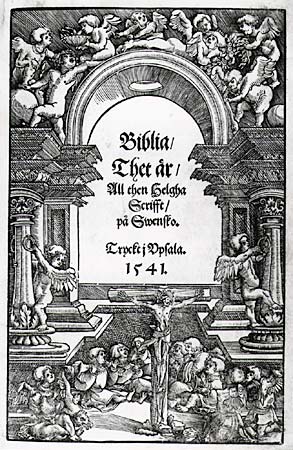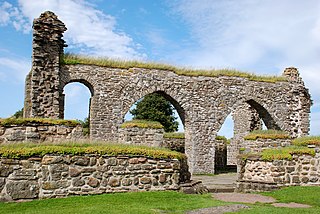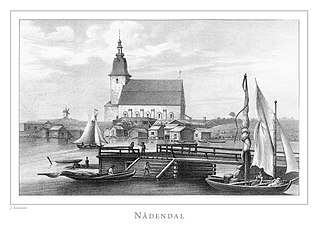Related Research Articles

The dissolution of the monasteries, occasionally referred to as the suppression of the monasteries, was the set of administrative and legal processes between 1536 and 1541, by which Henry VIII disbanded Catholic monasteries, priories, convents, and friaries in England, Wales, and Ireland; seized their income; disposed of their assets; and provided for their former personnel and functions.

The early Vasa era is a period in Swedish history that lasted between 1523–1611. It began with the reconquest of Stockholm by Gustav Vasa and his men from the Danes in 1523, which was triggered by the event known as the Stockholm Bloodbath in 1520, and then was followed up by Sweden's secession from the Kalmar Union, and continued with the reign of Gustav's sons Eric XIV, John III, John's son Sigismund, and finally Gustav's youngest son Charles IX. The era was followed by a period commonly referred to as the Swedish Empire, or Stormaktstiden in Swedish, which means "Era Of Great Power".

Although the Kingdom of Bohemia, both of the Lusatias, the Margraviate of Moravia, and Silesia were all under Habsburg rule, they followed different paths of development. Moravians and Silesians had accepted the hereditary right of the Austrian Habsburgs to rule and thus escaped the intense struggle between native estates and the Habsburg monarchy that was to characterize Bohemian history. In contrast, the Bohemian Kingdom had entrenched estates that were ready to defend what they considered their rights and liberties. The Habsburgs pursued a policy of centralization and conflict arose, which was further complicated by ethnic and religious issues.

The English Reformation Parliament, which sat from 3 November 1529 to 14 April 1536, established the legal basis for the English Reformation, passing major pieces of legislation leading to the break with Rome and increasing the authority of the Church of England. Under the direction of King Henry VIII of England, the Reformation Parliament was the first in English history to deal with major religious legislation, much of it orchestrated by, among others, the Boleyn family and Thomas Cromwell. This legislation transferred many aspects of English life away from the control of the Catholic Church to control under The Crown. This action both set a precedent for future monarchs to utilize parliamentary statutes affecting the Church of England; strengthened the role of the English Parliament; and provided a significant transference of wealth from the Catholic Church to the English Crown.

The Abbey Pax Mariae, more commonly referred to as Vadstena Abbey, is situated on Lake Vättern in the Roman Catholic Diocese of Stockholm and is a monastery of nuns within the Bridgettine Order. It was active from 1346 until 1595 and has been active since 1963, regaining status as an autonomous abbey in 1991.
In the Great Reduction of 1680, by which the ancient landed nobility lost its power base, the Swedish Crown recaptured lands earlier granted to the nobility. Reductions in Sweden and its dominions were the return to the crown of fiefs that had been granted to the Swedish nobility. Several reductions are recorded, from the 13th century until this final one of 1680.
Little Agda and Olof the Silent, refers to a legend about a young couple in Sweden between the very first years of King Gustav Vasa (1523) and the last years of before the Lutheran Reformation (1527).

During the Reformation, the territories ruled by the Danish-based House of Oldenburg converted from Catholicism to Lutheranism. After the break-up of the Kalmar Union in 1521/1523, these realms included the kingdoms of Denmark and Norway and the Duchies of Schleswig and Holstein, whereby Denmark also extended over today's Gotland and Øsel in Estonia.
Ebba Eriksdotter Vasa was a Swedish noblewoman. She was the mother of Queen Margaret Leijonhufvud and the second cousin and mother-in-law of King Gustav Vasa.
The suppression of monasteries refers to various events at different times and places when monastic foundations were abolished and their possessions were appropriated by the state.
Anna Karlsdotter (Vinstorpa) (died 1552), was a Swedish noble and landholder. By her daughter Ebba Eriksdotter Vasa, she was the maternal grandmother of Queen Margaret Leijonhufvud and thereby great-grandmother of King John III of Sweden and King Charles IX of Sweden. She is remembered as one of several possible people later identified with the famous legend of Pintorpafrun.

The Reformation in Sweden is generally regarded as having begun in 1527 during the reign of King Gustav I of Sweden, but the process was slow and was not definitively decided until the Uppsala Synod of 1593, in the wake of an attempted counter-reformation during the reign of John III (1568–1592).

Gudhem Abbey is the ruin of a nunnery which was in operation from 1152 to 1529. It is located in Gudhem outside Falköping in the Falbygden area in Västergötland, Sweden. It was initially part of the Benedictine and later Cistercian order. It is considered to have been one of the oldest convents in Sweden; after Vreta Abbey (1100) and Alvastra Abbey (1143).

Nådendal Abbey, was a Bridgettine abbey in then-Swedish Finland, in operation from 1438 to 1591. The abbey was first situated in Masku, secondly in Perniö (1441) and finally in Naantali in 1443. It was one of six monasteries in Finland during the Middle Ages, and, as a double monastery, the only one which accepted women.

Sko Abbey, was a Cistercian nunnery in Sweden, in operation from 1230 until at least 1588. It was located in the Skokloster parish in Uppland. It was the predecessor of the baroque Skokloster Castle.

Riseberga Abbey, was a Cistercian nunnery in Sweden, in operation from circa 1180 until 1534. It was located near Fjugesta in Närke. It had the right to appoint the vicar of the Edsberg parish, which was under the jurisdiction of the abbey. The ruins of the buildings are preserved, and the Amphitheatre of the abbey are presently used as a Sylvan theater.

Skänninge Abbey, also known as St. Ingrid's Priory, St. Martin's Priory or Skänninge Nunnery, was a Roman Catholic convent for females of the Dominican Order in Skänninge in Sweden, in operation from 1272 until 1544. It was founded by Saint Ingrid of Skänninge, and the center of her cult, and as such, it was often referred to as St. Ingrid's Priory. Located near the church dedicated to Martin of Tours, it was originally named St. Martin's Priory, though this name was rarely used in practice. The common name for it was Skänninge Abbey, but as there was also a convent for male members of the Dominican Order in Skänninge, it was often called Skänninge Nunnery to separate it from the male monastery.
Events from the year 1527 in Sweden
Events from the year 1525 in Sweden
Valborg Joakimsdotter Fleming was a Finnish abbess. She was the abbess of Nådendal Abbey in 1526–1531.
References
- Reduktion, hist., 6. Gustaf Vasas reduktion från kyrkan i Nordisk familjebok (andra upplagan, 1915)
You can help expand this article with text translated from the corresponding article in Swedish. (December 2017)Click [show] for important translation instructions.
|
